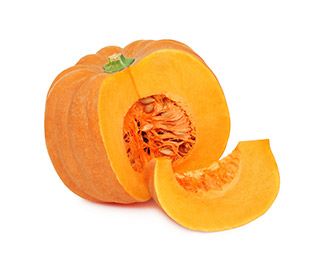Pumpkins are large, vining plants that belong to the Cucurbitaceae (gourd) family, and are often associated with fall, Halloween and Thanksgiving. The four main types are:
- Pepo, a smaller type of pumpkin that is best known for being carved into jack-o’-lanterns for Halloween
- Maxima, the giant variety usually grown to enter pumpkin contests at the county fair
- Mixta, which are often used as ornamental decorations
- Moschata, the variety used for making canned pumpkin products
- pepo, also called sugar pumpkin, originates from North America. This pumpkin can weigh anywhere from 30 grams (1 ounce) to 20 kilograms (705 ounces). Some varieties have smooth surfaces, while others are ribbed or lobed. C. pepo also comes in different colors, such as yellow, orange and green. Meanwhile, C. maxima, also called mammoth, is teardrop-shaped or rounded, and varieties come in pink, light blue and orange.
The hollow center of a pumpkin comes with dozens of off-white seeds, as many as 500 per fruit, attached to a pulpy matter. After cutting your pumpkin in half lengthwise, the pulp can be disposed of after saving the seeds (if you desire). Pumpkin seeds are a great source of calcium, protein and omega-3 fatty acids, and can be dried and salted for a homemade snack or saved to plant in the spring.
Health Benefits of Pumpkins
The only difference between 100 grams of raw and cooked pumpkin is a 6-calorie increase in the raw form. So where do the nutrients come from? It’s in the vitamins and minerals, including 0.5 grams of fiber and 426 micrograms of vitamin A.
Pumpkins also provide vitamin C, riboflavin, potassium, phosphorus and magnesium. Smaller but significant amounts of vitamin E (alpha tocopherol), thiamin, niacin, vitamin B6, folate and iron are present.
The bright orange color of the pumpkin also hints at the presence of a particularly beneficial phytonutrient: carotene. This converts to vitamin A in the body for a tremendous punch of antioxidants with the capacity to help reduce the risk of heart disease and cancer, as well slowing down the signs of aging, such as the formation of wrinkles.
Vitamin A is also a must for good vision and for helping to lower the risk of certain cancers. Flavonoids such as cryptoxanthin, lutein and zeaxanthin destroy harmful free radicals. Zeaxanthin and lutein, in particular, help protect the retina of the eye from macular degeneration.
Dried pumpkin seeds are not only a tasty, handy snack, but also a concentrated source of minerals and vitamins, with 30 grams of protein, 8.82 milligrams of iron and 559 calories in every 100-gram serving, but no cholesterol. The dietary fiber helps maintain regular waste elimination and helps keep the colon safe from diseases.
A special bonus in pumpkin seeds is the amino acid tryptophan, which, once in the brain, converts into serotonin, a nutrient that helps regulate brain function. For more information about the nutrients found in pumpkin, refer to the table below.
| Pumpkin Nutrition Facts
Serving Size: 3.5 ounces (100 grams), raw |
||
| Amt. Per Serving |
% Daily Value* |
|
| Calories | 26 | |
| Total Fat | 0 g | |
| Saturated Fat | 0.052 g | |
| Trans Fat | ||
| Cholesterol | 0 mg | |
| Sodium | 1 mg | |
| Total Carbohydrates | 6.5 g | |
| Dietary Fiber | 0.5 g | |
| Sugar | 2.76 g | |
| Protein | 1 g | |
| Vitamin A426 µg | Vitamin C | 9 mg |
| Calcium21 mg | Iron | 0.8 mg |
Studies Done on Pumpkins
Dietary intake of lycopene and other carotenoids was found to help inhibit prostate cancer in studies done on 130 patients with the disease and 274 inpatients without. The prostate cancer risk declined with increasing consumption of lycopene, alpha-carotene, beta-carotene, beta-cryptoxanthin, lutein and zeaxanthin — all found in pumpkins. Intake of watermelon, citrus fruits and three vegetables, including pumpkins, was also inversely associated with the prostate cancer risk.
A University of Massachusetts study on obesity-linked, non-insulin-dependent diabetes and high blood pressure, higher in North America than anywhere, was linked to dietary changes toward high-calorie foods such as sugar, refined grain flour and sweetened beverages. Pumpkins, beans and maize were looked at for potentials of phenolic phytochemicals and found to have a positive inverse effect on diabetes and high blood pressure. Pumpkin showed the best overall potential in this regard.
Pumpkin Fun Facts
A little known fact about pumpkins is that they aren’t vegetables; they’re fruits. Grown in America for more than 5,000 years, they were an unknown commodity in Europe before Columbus arrived.
Summary
Chances are if somebody mentions pumpkins, the first thought will be pie or jack-o’-lanterns. However, pumpkins are also wonderful and warming when making soup, salad and casseroles. The list goes on, especially if you’re creative.
Pumpkins are related to cucumbers and melons and come in large and small varieties. The health benefits are amazing because of the combination of vitamins, minerals and other nutrients that make this autumn crop so unique.
Not only are pumpkins good for your heart thanks to their vitamin A content, but they also contain compounds like lycopene and carotenoids that are known to help diminish cancer cells, inhibit diabetes, slow down the signs of aging and reduce the risk of macular degeneration.
Pumpkin seeds are great for between-meal nibbling, but even greater in the nutrients department, and can provide a healthy alternative to sugary snacks.







Reviews
There are no reviews yet.